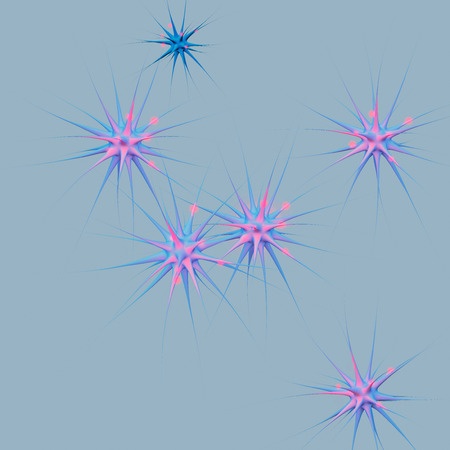Summary
Nervous system development is a complex biological process involving neuroblast proliferation, axonal growth, synaptic targeting, and neuronal survival. This article examines the cellular and molecular mechanisms underlying axon guidance and neuron selection, including the role of growth cones, neurotrophic factors, and gene regulation. Research in Drosophila and vertebrate models provides insights into the delicate balance between growth, targeting, and apoptosis in the formation of functional neuronal networks.
1. Introduction: From a single cell to neuronal complexity
The development of the nervous system begins with a single embryonic cell, which divides to produce neuroblasts. Although all individuals share the same biological basis, they exhibit distinct behaviors, largely due to the expression of genetic information contained in DNA. Genes, located in the nucleus of each cell, code for proteins and RNAs essential for cellular function. Even though all cells have the same genome, selective gene expression shapes the phenotype and function of neurons.
2. The role of axons in neuronal development
To form networks, neurons must establish connections through their axons, extensions responsible for transmitting electrical signals from the soma to target cells. These signals are translated into chemical or electrical messages at the level of the synapses, the junctions between neurons or between neurons and other cell types.
There are two types of synapses:
Chemical synapses, using neurotransmitters,
Electrical synapses, based on communicating junctions (gap junctions).
The end of the axons is provided with a growth cone, a mobile structure that allows the axon to detect and follow environmental signals.
3. Growth cone dynamics and axon guidance
During embryonic development, axons often have to travel long distances to reach specific targets (muscles, glands, other neurons). The growth cone plays a key role in this navigation. It is made up of lamellipodia and of filopodia, actin-rich structures that extend and retract in response to the environment.
Guidance is influenced by signals:
Chemotactic agents (local contact with cells),
Chemotropics (diffusible signals of attraction or repulsion).
Once the target is reached, the cone stabilizes, flattens, forms a synapse and stops its progression.
4. Midline crossing and genetic regulation
Some axons must cross the midline of the nervous system to reach their targets, such as commissural axons. Studies on mutants of the fruit fly (Seeger et al., 1993) have identified genes involved in this crossing:
The gene robot prevents repeated crossing of the center line,
The gene comm initially facilitates it,
The protein Slit (sli) acts as a repellent, interacting with robo and comm to ensure precise guidance (Kidd et al., 1999).
5. Neuronal selection and apoptosis
The developing nervous system produces a excess neurons, a large part of which dies by apoptosis (programmed cell death). This ensures that only neurons that have established adequate connections survive. The researcher Viktor Hamburger showed that the survival of peripheral neurons depended on the size of their target.
In the central nervous system, Dennis O'Leary observed that up to 50 % retinal ganglion cells die in the first postnatal days if they fail to connect or if the targets are too small (O'Leary, 1987).
Apoptosis is regulated by neurotrophic factors, in particular the nerve growth factor (NGF) discovered by Rita Levi-Montalcini, which promotes the survival of sympathetic neurons. Other neurotrophins have similar effects on motor and sensory neurons.
6. Postnatal neurogenesis and environmental influence
If neurogenesis is very active during the embryonic period, it decreases sharply after birth, except for a few areas like theseahorseThe mechanisms of reactivation of adult neurogenesis remain poorly understood, as does the molecular cascade that triggers postnatal apoptosis.
The environment also plays a major role. Research on infants shows that early sensory and affective experiences influence neuronal connections and synaptic plasticity. Brain development therefore relies both on genetics and experience.
7. Conclusion
Neural development relies on a subtle interaction between genetic factors, environmental signals and cellular mechanisms. Axon guidance, synaptic formation and neuronal selection are all precisely regulated steps. While the discoveries have identified key mechanisms, many questions remain, particularly regarding adult neurogenesis and the integration of environmental factors into neuronal maturation.
References
Hollyday, M. & Hamburger, V. (1976). Reduction of the naturally occurring motor neuron loss by enlargement of the periphery. Journal of Comparative Neurology, 170, 311–320.
Kidd, T., Bland, K.S., & Goodman, C.S. (1999). Slit is the midline repellent for the Robo receptor in Drosophila. Cell, 96, 785–794.
Levi-Montalcini, R. (1975). NGF an uncharted route. In Worden, FG, Swazey, JP, & Adelman, G. (Eds.), The Neurosciences: Paths of Discovery (pp. 245–265). MIT Press.
O'Leary, D. (1987). Remodeling of early axonal projections through selective elimination of neurons and long axon collaterals. In Bock, G. & O'Connor, M. (Eds.), Selective Neuronal Death, Ciba Foundation Symposium (pp. 113–130). Wiley.
Seeger, M., Tear, G., Ferres-Marco, D., & Goodman, C.S. (1993). Mutations affecting growth cone guidance in Drosophila: Genes necessary for guidance toward or away from the midline. Neuron, 10, 409–426.



